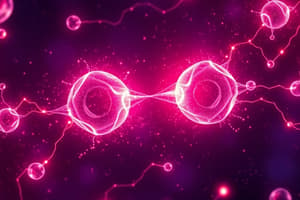Podcast
Questions and Answers
Which of the following compounds primarily exhibits ionic bonding?
Which of the following compounds primarily exhibits ionic bonding?
- O2
- H2O
- NaCl (correct)
- CO2
In ionic bonding, electrons are shared equally between atoms.
In ionic bonding, electrons are shared equally between atoms.
False (B)
Name one factor that influences the strength of ionic bonds.
Name one factor that influences the strength of ionic bonds.
Electronegativity difference
In ionic bonding, metallic elements typically _____ electrons while nonmetallic elements _____ electrons.
In ionic bonding, metallic elements typically _____ electrons while nonmetallic elements _____ electrons.
Match the following compounds with their respective ionic formula:
Match the following compounds with their respective ionic formula:
What is the equilibrium separation in ionic bonding characterized by?
What is the equilibrium separation in ionic bonding characterized by?
Electronegativity differences greater than 2 typically lead to covalent bonding.
Electronegativity differences greater than 2 typically lead to covalent bonding.
What type of interaction primarily characterizes ionic bonding?
What type of interaction primarily characterizes ionic bonding?
Which group contains inert gases with stable electron configurations?
Which group contains inert gases with stable electron configurations?
Electronegativity ranges from 1.0 to 4.0.
Electronegativity ranges from 1.0 to 4.0.
What type of elements are known to readily acquire electrons?
What type of elements are known to readily acquire electrons?
Group IA elements are known as __________ metals.
Group IA elements are known as __________ metals.
Match the following groups with their characteristics:
Match the following groups with their characteristics:
What is the primary characteristic of transition metals?
What is the primary characteristic of transition metals?
Electropositive elements gain electrons to form negative ions.
Electropositive elements gain electrons to form negative ions.
If an element acquires two electrons, it becomes a __________ ion.
If an element acquires two electrons, it becomes a __________ ion.
What type of bond is formed when two atoms have similar electronegativities?
What type of bond is formed when two atoms have similar electronegativities?
A bond with an electronegativity difference of 0.4 to 2.0 is classified as a polar covalent bond.
A bond with an electronegativity difference of 0.4 to 2.0 is classified as a polar covalent bond.
What is formed by the delocalization of electrons in metallic bonding?
What is formed by the delocalization of electrons in metallic bonding?
The formula to approximate the percent ionic character (%IC) of a bond is % IC = 100 × 1 − exp −0.25(ξA − ξ B )². Here, ξA and ξB represent the __________ of the two elements.
The formula to approximate the percent ionic character (%IC) of a bond is % IC = 100 × 1 − exp −0.25(ξA − ξ B )². Here, ξA and ξB represent the __________ of the two elements.
Match each term with its description:
Match each term with its description:
Which of the following pairs would most likely form a polar covalent bond?
Which of the following pairs would most likely form a polar covalent bond?
The bond in sodium chloride (NaCl) is primarily covalent.
The bond in sodium chloride (NaCl) is primarily covalent.
Calculate the percent ionic character of the bond in MgO using the electronegativities provided: XMg = 1.2 and XO = 3.5. Show your calculations.
Calculate the percent ionic character of the bond in MgO using the electronegativities provided: XMg = 1.2 and XO = 3.5. Show your calculations.
Flashcards are hidden until you start studying
Study Notes
Ionic Bonding
- Ionic bonding involves the transfer of electrons from metallic to nonmetallic elements, resulting in strong Coulombic interactions.
- Stability arises when net energy, computed from attractive and repulsive energies, is at a minimum.
- Common examples of ionic compounds: NaCl, MgO, CaF2, CsCl.
- Electron transfer is energetically favorable, leading to reduced atomic energy states.
Periodic Table Structure
- The table consists of 7 periods (horizontal rows) and various groups (columns) with similar valence electron configurations.
- Groups are characterized by their tendency to gain or lose electrons:
- Group 0: Inert Gases (stable configurations).
- Group IA: Alkali Metals (one excess electron).
- Group IIA: Alkaline Earth Metals (two excess electrons).
- Groups VIIA & VIA: Halogens and Chalcogens (one or two electrons deficient).
- Electronegativity trends: Electropositive elements lose electrons to form positive ions, while electronegative elements acquire electrons to form negative ions.
Electronegativity
- Electronegativity values range from 0.7 to 4.0, indicating an element's tendency to acquire electrons.
- Higher electronegativity correlates with a stronger tendency to attract electrons.
Covalent Bonding
- Covalent bonding occurs between atoms with similar electronegativities, leading to electron sharing.
- Primarily involves valence electrons found in s and p orbitals (e.g., H2 molecule).
- Polar covalent bonds form when electronegativity differences are between 0.4 and 2.0, producing bonds with partial ionic character.
Mixed Bonding
- Mixed bonding primarily consists of covalent-ionic bonding.
- The ionic character of mixed bonds can be calculated using the electronegativities of the participating elements.
Metallic Bonding
- Metallic bonding features delocalized electrons forming an electron cloud, allowing for conductivity and malleability of metals.
Studying That Suits You
Use AI to generate personalized quizzes and flashcards to suit your learning preferences.




